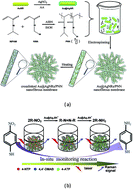Fabrication of monodispersed Au@Ag bimetallic nanorod-loaded nanofibrous membrane with fast thermo-responsiveness and its use as a smart free-standing SERS substrate†
Abstract
A novel type of metal nanoparticle-loaded smart nanofibrous membrane with fast thermo-responsiveness was fabricated by electrospinning an aqueous solution containing poly(N-isopropylacrylamide-co-N-hydroxymethylacrylamide) and monodispersed Au@Ag bimetallic nanorods with a core–shell structure, followed by heat treatment. The results obtained by electron microscopy show that the anisotropic nanoparticles are oriented along the axes of its constituent nanofibers. The membrane produced has high stability in aqueous media and remarkable thermo-responsiveness. It takes less than 10 seconds to reach its deswelling or swelling equilibrium state with the temperature alternating between 25 °C and 50 °C. The smart nanofibrous membrane with macroscopic mechanical strength can be used as a free-standing surface-enhanced Raman scattering (SERS) substrate with high Raman signal reproducibility for quantitative analysis, and its SERS efficiency can be readily elevated by raising the detection temperature across its phase transition temperature due to its fast thermo-response rate. Particularly, since the composite nanofibrous membrane possesses catalytic properties toward the reduction of 4-nitrothiophenol to 4-aminothiophenol by NaBH4, it has the ability to act as an in situ SERS monitor for the reaction, and it was deduced from the detected intermediate that the reaction proceeds via a condensation reaction route.

- This article is part of the themed collection: Surface enhanced Raman Spectroscopy: Editors collection for RSC Advances


 Please wait while we load your content...
Please wait while we load your content...